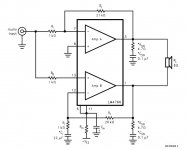Hi
Pulled this out of a datasheet.
Why are the values of the NFB resistor different in the two halves of the amp? I assume there is a quality buffer before the power amp (which this is), and the circuit below is used. Why is one having a gain of 20, and the other 21?
Or is it for impedance compensation?
Pulled this out of a datasheet.
Why are the values of the NFB resistor different in the two halves of the amp? I assume there is a quality buffer before the power amp (which this is), and the circuit below is used. Why is one having a gain of 20, and the other 21?
Or is it for impedance compensation?
Gain
Hi,
Isn't Vo= (1+ Rfb/Ri) Vi (noninverting)
Vo= outputvoltage
Vi = inputvoltage
So the noninverting gain is Vo/Vi= 1+ Rfb/Ri
and the inverting gain is - Rfb/Ri (assuming zero source impedance)
😕
Hi,
Isn't Vo= (1+ Rfb/Ri) Vi (noninverting)
Vo= outputvoltage
Vi = inputvoltage
So the noninverting gain is Vo/Vi= 1+ Rfb/Ri
and the inverting gain is - Rfb/Ri (assuming zero source impedance)
😕
Re: Gain
Yes, I guess, whatever, but both above look the same to me (with the exception of the (-) sign in Elso's ) ??
Andypairo said:Inverting gain is Rfb/Ri, non-inverting gain is 1+Rfb/Ri.
Cheers
Andrea
Elso Kwak said:... So the noninverting gain is Vo/Vi= 1+ Rfb/Ri
and the inverting gain is - Rfb/Ri (assuming zero source impedance)
😕
Yes, I guess, whatever, but both above look the same to me (with the exception of the (-) sign in Elso's ) ??
- Status
- Not open for further replies.
- Home
- Amplifiers
- Solid State
- Bridge amp feedback
